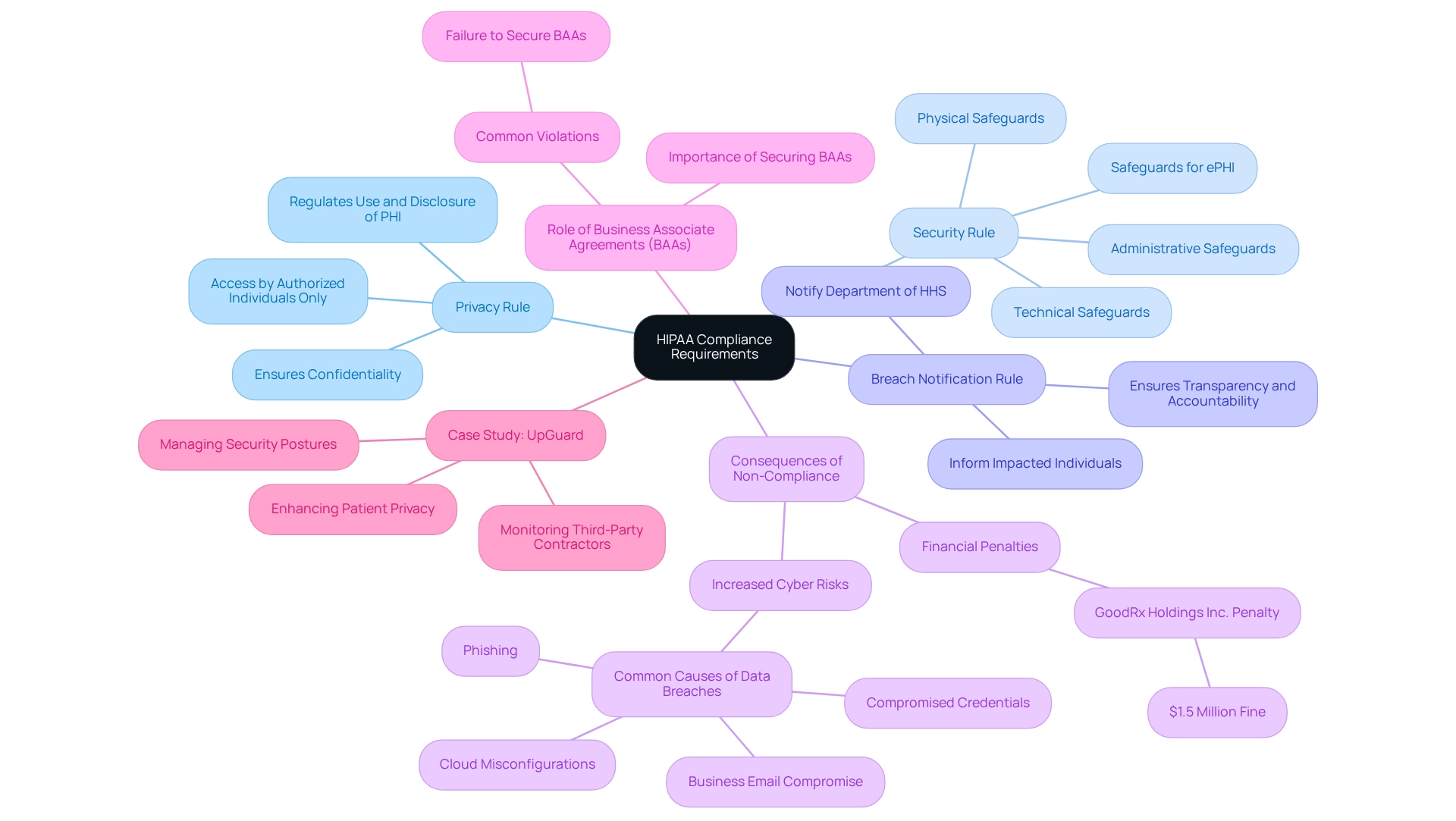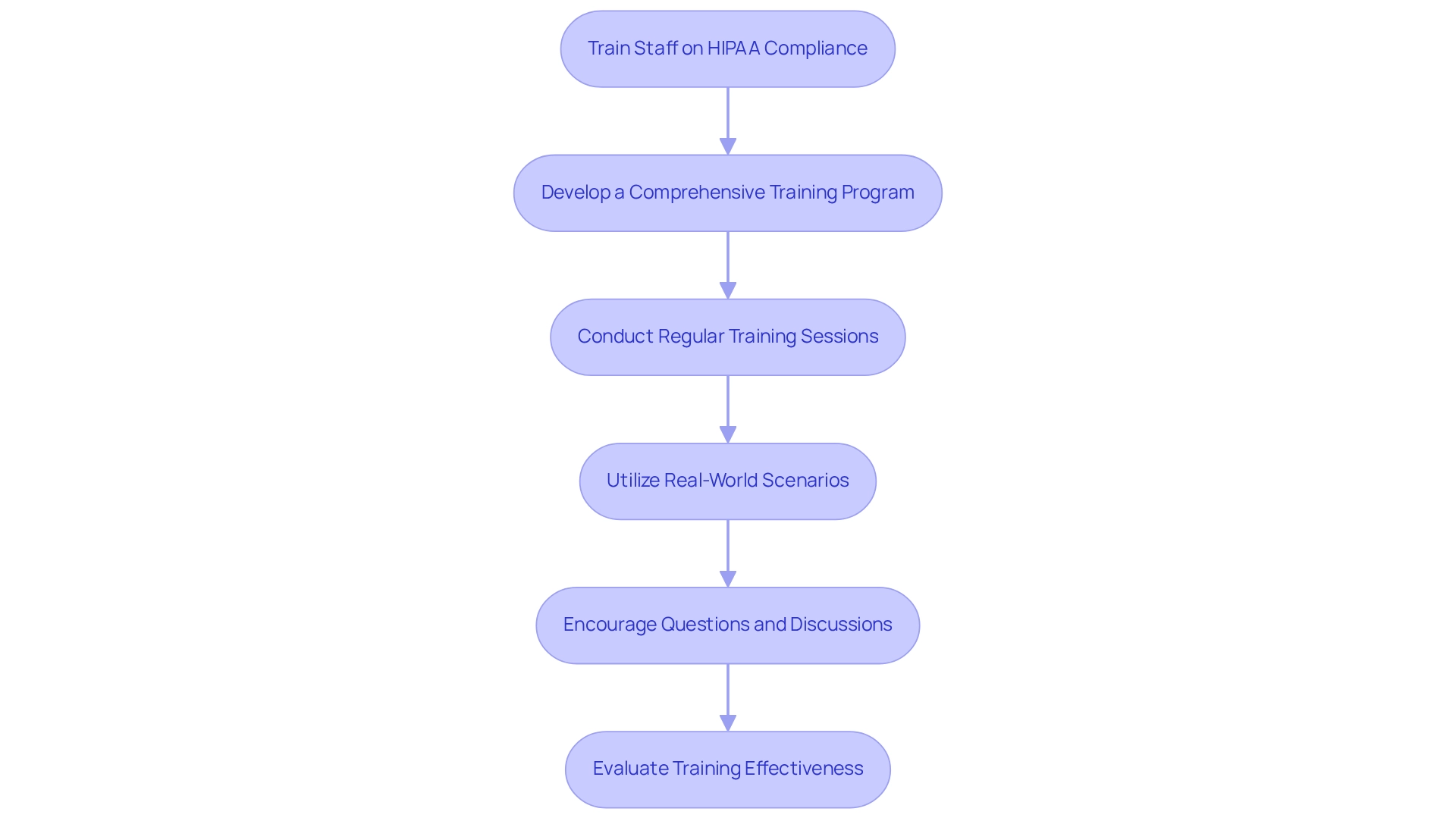Overview
Ensuring your AI scribe is HIPAA compliant is essential for protecting both your patients and your practice. Many healthcare providers face emotional challenges when navigating the complexities of HIPAA regulations. By prioritizing key features like encryption and access controls, you can alleviate some of these burdens and focus more on patient care.
Conducting regular compliance audits and training staff on best practices are vital steps in this process. These actions not only safeguard Protected Health Information (PHI) but also foster a culture of awareness and responsibility within your team. The risks of non-compliance can have serious implications, and real-world examples serve as a reminder of the importance of thorough training and oversight in maintaining patient confidentiality.
Reflect on how these proactive measures can enhance the trust and safety of your practice. By taking these steps, you are not just meeting regulatory requirements; you are also demonstrating your commitment to your patients' well-being. Let’s work together to ensure that compliance becomes a seamless part of your operations, allowing you to focus on what truly matters—caring for your patients.
Introduction
In the realm of healthcare, the integration of artificial intelligence (AI) tools holds the promise to transform patient care, yet it also brings forth significant concerns about the safeguarding of sensitive health information. As healthcare providers embrace AI scribes, it is essential to understand the complexities of HIPAA compliance. This article explores the crucial elements of the Health Insurance Portability and Accountability Act (HIPAA), outlining the key requirements organizations must follow to protect Protected Health Information (PHI).
Consider the emotional challenges faced by healthcare providers: the pressure to deliver excellent patient care while managing administrative burdens can be overwhelming. Identifying essential features in AI technology, conducting regular audits, and training staff on best practices are vital steps toward ensuring compliance. These measures not only help in navigating the regulatory landscape but also play a crucial role in maintaining patient trust and safety.
As the stakes continue to rise, it is imperative for organizations to equip themselves with the knowledge and strategies necessary to effectively navigate this complex environment. By doing so, they can alleviate some of the burdens on healthcare providers, allowing them to focus more on what truly matters—their patients.
Understand HIPAA Compliance Requirements
To ensure that your AI scribe is HIPAA compliant, it's vital to understand the key components of the Health Insurance Portability and Accountability Act (HIPAA). This important legislation establishes national standards for safeguarding health information, particularly focusing on the privacy and security of Protected Health Information (PHI). The primary requirements include:
- Privacy Rule: This rule regulates the use and disclosure of PHI, ensuring that patient information remains confidential and is accessed only by authorized individuals.
- Security Rule: This rule specifies the necessary safeguards to protect electronic PHI (ePHI) from unauthorized access. It encompasses administrative, physical, and technical safeguards designed to maintain the integrity and confidentiality of health data.
- Breach Notification Rule: This requires that covered entities inform impacted individuals and the Department of Health and Human Services (HHS) in the event of a breach, ensuring transparency and accountability.
As we look ahead to 2025, it's important for healthcare providers to recognize that many still lack a thorough understanding of the Privacy and Security Rules. This gap can lead to serious penalties. For instance, GoodRx Holdings Inc. faced a $1.5 million penalty for not informing consumers about unauthorized disclosures, highlighting the financial risks linked to non-adherence.
Real-world instances illustrate the significance of HIPAA adherence in AI healthcare tools. Entities like UpGuard have shown that overseeing security stances and supervising external contractors can greatly improve patient privacy and safeguard sensitive medical information. In the context of AI scribes, ensuring these tools are designed with strong adherence measures is vital to mitigate risks associated with data breaches, often caused by compromised credentials, phishing, and cloud misconfigurations.
Furthermore, securing Business Associate Agreements (BAAs) with vendors involved in AI technology is essential. The absence of a BAA is one of the most frequent violations of health information privacy regulations, as observed by Kent Cañas. Grasping these elements will empower you to assess whether your AI scribe is HIPAA compliant, which is essential for protecting patient information and enhancing the overall security of your healthcare practice.

Identify Key Features for HIPAA Compliance in AI Scribes
When selecting an AI scribe, it is essential to prioritize key features that determine if the scribe is HIPAA compliant, as these choices can significantly impact the quality of patient care. This is crucial; effective information encryption is a fundamental requirement for maintaining patient confidentiality and trust. Strong encryption techniques are vital in protecting sensitive information from advancing cyber threats.
-
Access Controls: Robust access controls are vital, allowing only authorized personnel to access sensitive information. This feature helps reduce the risk of information breaches, which have been reported at an alarming rate—an average of two significant breaches occurring daily in recent years, according to the HIPAA Journal. Implementing strict access controls is essential for maintaining the integrity of healthcare data, as a compliant AI scribe is HIPAA compliant by maintaining detailed logs of all access and modifications to PHI. These audit trails promote accountability and transparency, enabling healthcare organizations to track who accessed patient information and when, thus strengthening ethical obligations. Maintaining thorough audit trails is essential for ensuring effective data protection strategies.
-
Business Associate Agreement (BAA): It is imperative to confirm that the AI vendor is willing to sign a BAA. This legal obligation ensures that any third-party service managing PHI is contractually required to safeguard that information. A signed BAA is a critical component of compliance and risk management.
-
Regular Security Updates: The AI tool should receive regular updates to address potential vulnerabilities and enhance security measures. Continuous improvement in security protocols is essential to adapt to evolving threats in the healthcare landscape. Organizations must prioritize suppliers that show a dedication to continuous security improvements, ensuring that their services are HIPAA compliant, which can significantly diminish the likelihood of regulatory infractions and improve the overall safety of health information for healthcare providers. The implementation of robust data protection strategies is not just a regulatory requirement; it is a fundamental aspect of ethical patient care. Together, we can work towards a safer, more secure healthcare environment.

Conduct Regular Compliance Audits and Assessments
To ensure compliance with health information regulations, it’s vital to conduct regular audits and assessments of your AI scribe's operations. Consider these steps to ensure that your organization is scribe HIPAA compliant:
- Establish Audit Protocols: Create a timetable for routine audits, ideally at least once a year, to ensure adherence to health regulations.
- Review Policies and Procedures: Evaluate your existing policies regarding the use of the AI scribe, confirming that the AI scribe is HIPAA compliant with the required regulations.
- Evaluate Security Measures: Assess the effectiveness of security protocols, including encryption, access controls, and incident response plans, to protect patient data.
- Identify and Address Gaps: Document any regulatory gaps discovered during the audit and develop a plan for prompt resolution.
Engaging third-party auditors with expertise in health information privacy regulations is crucial for an objective evaluation of your practices to ensure that your scribe is HIPAA compliant, while regular audits also foster a culture of accountability within your organization. In 2023, HIPAA violations impacted around 134,787,438 individuals, underscoring the essential need for strong protection strategies. Moreover, the HHS is only required to disclose breaches affecting 500 or more individuals under the HITECH Act, highlighting the importance of proactive adherence measures. The frequency of data breaches involving 500 or more medical records has significantly increased from 2009 to 2021, illustrating the urgency for regular audits. By prioritizing these assessments, healthcare organizations can effectively mitigate risks and confirm that their AI tools are scribe HIPAA compliant.
Are you ready to take these vital steps towards ensuring compliance and safeguarding patient data? Your commitment to these practices not only protects your organization but also supports the well-being of those you serve.

Train Staff on HIPAA Compliance Best Practices
Educating personnel on regulatory adherence best practices is vital for protecting individual information and nurturing trust in healthcare services. By implementing the following strategies, you can ensure effective training that resonates with your team's needs:
- Develop a Comprehensive Training Program: Establish a robust training curriculum that encompasses healthcare regulations, the importance of patient privacy, and specific adherence measures related to the AI scribe. Tailor this program to the unique needs of your organization and the technology in use, recognizing that a personalized approach enhances engagement.
- Conduct Regular Training Sessions: Schedule training sessions at least annually, with additional sessions for new hires or when significant changes occur in regulations or technology. Ongoing education is essential, especially considering that 45% of organizations never assess employees on HIPAA training, highlighting a significant gap in adherence efforts.
- Utilize Real-World Scenarios: Incorporate case studies and real-world situations to illustrate the significance of adherence and the potential consequences of violations. For instance, the case study titled "Empowerment in Data Handling" demonstrates how comprehensive education on data protection measures empowers healthcare professionals to handle patient data confidently, reducing errors and promoting proactive data management.
- Encourage Questions and Discussions: Foster an open atmosphere where staff feel at ease asking questions and discussing regulatory challenges. This conversation can deepen understanding and retention of regulatory principles, allowing for a supportive learning environment.
- Evaluate Training Effectiveness: Regularly assess the success of your training program through quizzes, feedback, and audits. This evaluation process is essential for ongoing enhancement and ensuring that staff are well-prepared to manage client data responsibly. Given the rise in healthcare penalties imposed in 2021 and 2022, emphasizing training on regulations is crucial to reducing risks.
By prioritizing employee training, you cultivate a culture of adherence that not only safeguards client information but also enhances the overall integrity of your organization. As Steve Alder, Editor-in-Chief of The HIPAA Journal, emphasizes, effective training is a cornerstone of maintaining compliance and safeguarding patient data.

Conclusion
The integration of AI tools in healthcare holds immense promise for transforming patient care. However, it also brings forth emotional challenges, particularly around the necessity of understanding HIPAA compliance to protect sensitive health information. Key elements such as the Privacy Rule, Security Rule, and Breach Notification Rule form the backbone of HIPAA, ensuring that healthcare providers can safeguard Protected Health Information (PHI). By prioritizing features like data encryption, access controls, and regular security updates in AI scribes, organizations can significantly reduce the risk of breaches and enhance patient trust.
Conducting regular audits and assessments can further strengthen compliance efforts. This proactive approach allows organizations to identify gaps and reinforce data protection strategies. Moreover, training staff on HIPAA best practices is essential to foster a culture of accountability, ensuring that all team members are equipped to handle patient data responsibly. The alarming rise in HIPAA violations underscores the urgency of these measures, as the stakes for both patient trust and organizational integrity continue to grow.
Ultimately, equipping themselves with the knowledge and resources necessary for effective HIPAA compliance enables healthcare providers to alleviate administrative burdens. This focus allows them to concentrate on what truly matters—delivering exceptional care to their patients. Embracing these strategies not only aligns with regulatory requirements but also reinforces a commitment to patient safety and confidentiality in an increasingly complex healthcare landscape.
Key Solutions for Effective HIPAA Compliance:
- Prioritize data encryption and access controls.
- Conduct regular audits and assessments.
- Train staff on HIPAA best practices.
By taking these steps, healthcare providers can foster a nurturing environment that promotes trust and safety, ensuring that patient care remains at the forefront of their mission.




